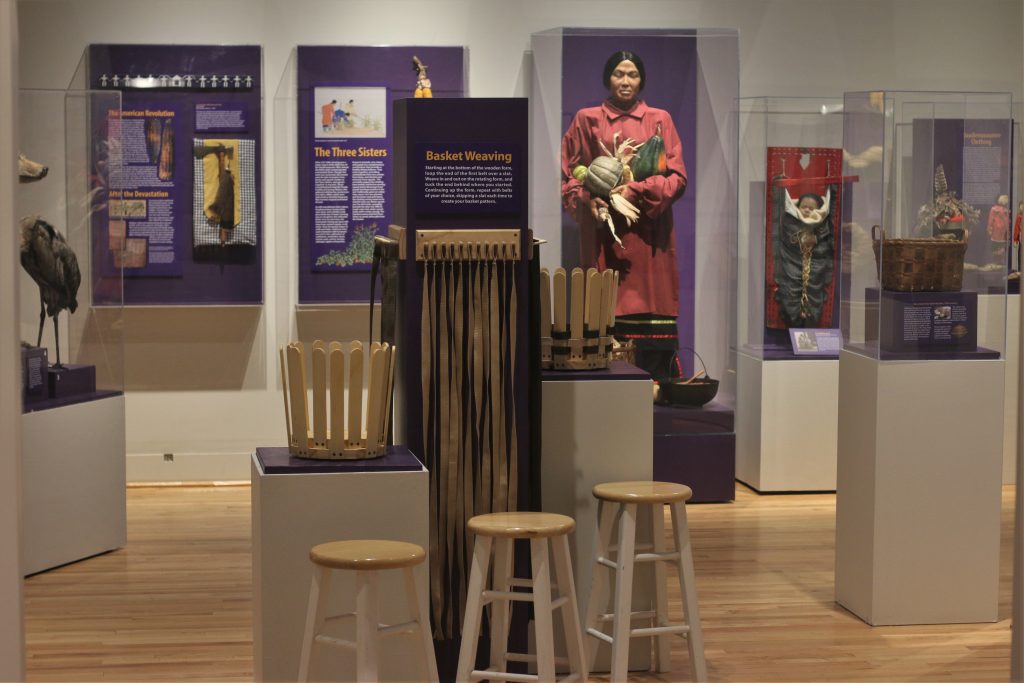On April 30, the Roberson Museum and Science Center unveiled “Haudenosaunee: People of the Longhouse” as a revitalization of an already-standing exhibition. In collaboration with experts and faith leaders within the Haudenosaunee Confederacy, Roberson Museum and Science Center staff members worked to expand and renew the exhibition to showcase the life and work of the Haudenosaunee Confederacy. Michael Grasso, ‘07, an executive director for the Roberson Museum, said the exhibition is meant to show appreciation to the Haudenosaunee people who lived in what is present-day Broome County.
“The intent of the exhibition is to provide an overview that we hope will inspire people to look into [the Haudenosaunee Confederacy] and to express our gratitude for the Haudenosaunee who cared for this land and continue to do so,” Grasso said.
“Haudenosaunee: People of the Longhouse” has been one of Roberson Museum and Science Center’s permanent exhibitions for years, but has not been updated since the 1990s. With cultural sensitivities changing and our views on history needing to be updated, the museum staff wanted to make sure the exhibition was consistent with the times. Every single fourth-grade student within the Binghamton City School District visits this exhibition each year as part of the school curriculum. Grasso spoke on updates of the exhibit.
“It was really important for us to make sure that we are providing accurate information, not just for students, but for the community as well,” Grasso said.
The Haudenosaunee Confederacy, which is composed of five nations — Mohawk, Oneida, Cayuga, Seneca and Onondaga — originally joined together as a means for peaceful, united decision-making. Nonetheless, each nation maintains its own structure and beliefs, and the Confederacy allows a space for decision-making that affects the nations as a whole. The Longhouse is used as a symbol of each nation’s role and unity within the confederation — the Onondaga are the keepers of the Central Fire, the Mohawk, Seneca and Onondaga take on the role of the Elder Brothers and the Cayuga and Oneida are the Younger Brothers within the Confederacy. According to the Haudenosaunee Confederacy website, the structure of the Haudenosaunee Confederacy is believed to be the inspiration behind the U.S. Constitution, with a “unique” emphasis and “blending of law and values.” The Confederacy believes that “law, society and nature are equal partners and each plays an important role.”
“Where [Roberson Museum and Science Center] sits is … an archaeology dig site for Binghamton University from decades ago,” Grasso said. “I think it is really important to acknowledge that we are on land that was home to these people until colonization happened.”
In acknowledging that the museum is located on the homeland of the Onondaga Nation, the exhibition is used as a means to honor and celebrate the nations that have thrived and continue to do so. According to the Roberson Museum, the exhibition “offers visitors a walk through of a partial model of a longhouse, an opportunity to listen to how lacrosse sticks are made and watch traditional dances, weave patterns on baskets or feel the textures of beads, furs and hides.”
“This is still a thriving culture that still exists and is still producing art and music,” Grasso said. “Their history still continues to develop over time.”
The purpose of the “Haudenosaunee: People of the Longhouse” exhibition is to celebrate and honor their culture, accomplished by working with members of the Haudenosaunee Confederacy to create an accurate and informative exhibition, which is now on permanent display.
“This is not a dead or dying culture,” Grasso said. “This is not people who were. This is a people who are. We are doing our best to respectfully tell their story and hope to bring a little bit more engagement and enlightenment about the people who used to call this place home.”



